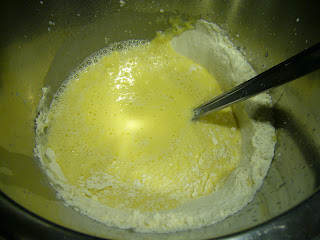You know, the sort that the English supposedly eat after church each Sunday - at least in the imagination of some writers of novels and food magazines.
The first thing is to weigh the meat again. This is important to help determine the time needed to cook the beef if you don't want to end up eating leather.
Since I had thrown out 550 grams of fat, I now had only about 2 kilos of real beef left.
The cookbooks and magazines I have read all seem to agree that to get a medium rare roast it should be cooked for 25 minutes for every 500 grams of meat in a 180 degree oven.
So I calculated I needed to cook the beef for 1 hour and 40 minutes.
This turned out to be not such a good idea.
The beef became more medium than rare.
It would have been better if I had taken it out of the oven at least 10 minutes before the end of the cooking time.
Still, it was easy enough getting to the final product.
Once you have calculated the cooking time, rub the beef with some garlic and freshly ground black pepper.
Then put it on a rack in a baking tray.
You can also put some potatoes in the tray so that they roast in the dripping from the beef.
There will be plenty of dripping.
That's more fat.
You may have cut off the visible extra fat - 550 grams in this case - but there will still be plenty that will come dripping out as the meat cooks.
But the potatoes will be happily soaking it up and turning into luscious, gleaming mounds of absolutely delicious killers as the beef sizzles away on top.
Cover the beef loosely with some foil to prevent it from turning brown too much too soon.
While the two are cooking, prepare the vegetables and yorkshire pudding.
Yes, yorkshire pudding.
Remember, this is that "traditional" English meal.
All you need is flour, milk, eggs, salt and some of the dripping from the beef.
Beat 3 eggs and mix it with 1 and a half pints of milk.
Sift 12 ounces flour and a pinch of salt into a mixing bowl.
Make a well in the flour and gradually beat in the milk and egg mixture to make a smooth batter.
Make sure there are no lumps.
Keep this batter in the fridge till the beef is done.
When the beef is out of the oven, cover it loosely with foil.
Uncover 5 to 10 minutes before the end of the cooking time to let the beef brown.
Let the roast rest for half an hour before serving.
Don't forget the potatoes.
Take them out of the tray and keep them warm.
Then, spoon some dripping into a pan and heat it for 2 minutes in the oven.
I used a 10 x 10 inch pan and also baked some in a muffin tray.
As the batter looked a bit too thick, I added a tablespoon of cold water to it and gave it a good stir before pouring it into the pan.
Bake it for about 20 minutes at 180 degrees.
The yorkshire pudding will puff up into something kind of ugly.
But rest assured, it will be delicious if served immediately with the roast and the potatoes.
Don't forget the vegetables.
I made glazed carrots and buttered broccoli.
And to round off the meal, a Bakewell Tart.





























